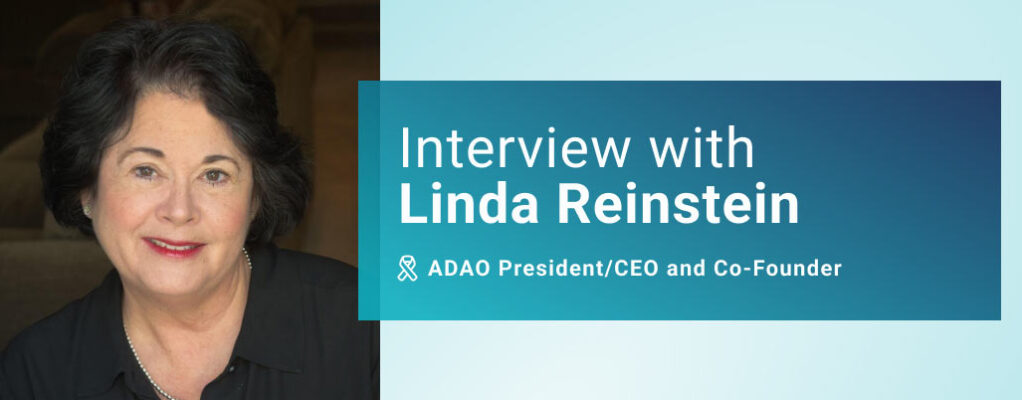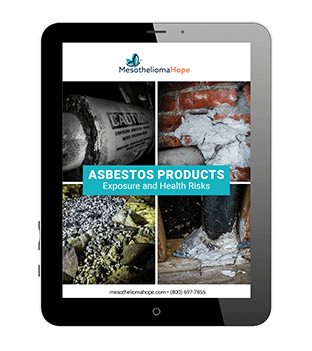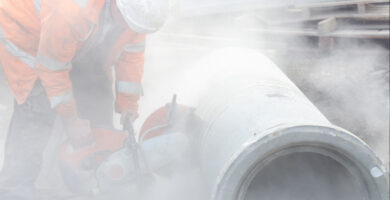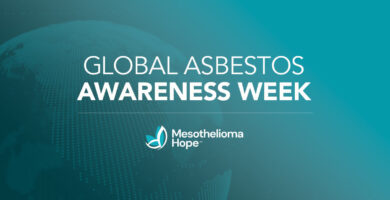In 2003, Linda Reinstein’s husband, Alan, was diagnosed with pleural mesothelioma, a rare cancer of the lung lining caused by asbestos exposure.
As she coped with the grief of her husband’s diagnosis, Linda co-founded the Asbestos Disease Awareness Organization (ADAO). Her mission was to prevent more people from suffering from avoidable yet devastating illnesses by urging policymakers to ban asbestos in all its uses.
Now 20 years later, Linda continues to fight on behalf of her husband, who sadly passed away in 2006, and the millions of people affected by the dangerous carcinogen asbestos.
As part of Global Asbestos Awareness Week, Mesothelioma Hope asked Linda questions about navigating the grief of losing her husband to mesothelioma and starting the largest asbestos advocacy organization. Here’s what she shared about her story of heartbreak and advocacy.
What was your reaction to Alan first being diagnosed with mesothelioma?
After enduring 9 months of symptoms and multiple visits to doctors, my husband, Alan, was diagnosed with pleural mesothelioma in 2003. I didn’t know anything about the disease, not even how to pronounce it. The learning curve for mesothelioma treatment and understanding your legal options was steep.
When the doctor told us what was going on, I was paralyzed with grief, fear, and disbelief. Our daughter Emily was only 10 — just a baby in our eyes. We were a typical American family — trusting that our government would protect our air, water, and soil from toxins — but I was wrong.
What treatment methods did he undergo? What were those like for him as a patient and you as a caregiver?
He underwent multiple surgeries and chemotherapy, including the radical extrapleural pneumonectomy (EPP) — a surgical procedure that removed his left lung and lining around his heart and replaced his diaphragm.
These were incredibly painful for both himself and for Emily and me. Watching someone you love in pain is torture.
While treatment gave us a few more years with him, mesothelioma is a cruel and deadly cancer. He died in 2006 with us by his side.
What’s a favorite memory about your late husband, Alan?
It’s impossible to choose a single favorite memory of someone you love and built a life with. But I will never forget the softness of his hand on my cheek or the gentleness of his voice, his profound wisdom, and the many adventures we shared, including marathons, skiing, and climbing Half Dome in Yosemite National Park.
How did you deal with the grief of losing your husband?
People sometimes don’t know how to talk to you when you are grieving. They want to help, but they also want you to be okay within 6 to 12 months, and that’s just not going to happen.
What those who haven’t lost someone don’t understand is that it changes you forever. Cancer, suffering, and death are not something that you can ever “shake off” or move on from. The grief will be ever-present for the rest of your life, the strength of it coming and going in waves at certain times. When I first lost Alan, I was bewildered, angry, and depressed.
My daughter is the one thing that kept me focused, kept me present. Without her, I would have been lost. She and I changed together and came out the other side different people.
Lastly, co-founding ADAO with Doug Larkin in 2004 gave my pain and grief an outlet. We are now people who are dedicated to making sure America bans asbestos so families don’t have to suffer like ours did. ADAO provides education and resources for families who are suffering and uses a dual-track method of legislation and regulation to fight for a world free of asbestos-caused diseases.
What advice would you give someone going through the same thing with their loved one?
There are four things I tell people who learn they have an asbestos-caused illness:
- Build your medical, financial, and legal plan — and share it with your loved ones.
- Surround yourself with family, friends, and medical experts.
- Invest in your self-care. I’m excited to share news of my upcoming self-care guide.
- Seek professional help as needed.
These are small steps you can take to begin to understand what you need to do.
Also, remember you are not alone. A caring community is available to asbestos victims, with many resources online and with your medical and legal team. Mesothelioma Hope has excellent free resources.
What do you wish everyone knew about asbestos?
I wish everyone recognized the deep and tragic impact asbestos continues to have on individuals and their families. This hazard persists in many environments, including homes, schools, and workplaces, causing harm, suffering, and death that is entirely preventable. Most people do not know that asbestos is still legal and lethal in America today.
Despite landmark steps being taken regarding asbestos imports and use in the 20 years since I started ADAO, more work needs to be done to fully safeguard Americans from this carcinogen.
The story of asbestos is not just data and distant tales but is reflected in the personal experiences of those like my husband, Alan, who suffered due to asbestos exposure.
It is critical to remind everyone asbestos is a known carcinogen, and there is no safe level of exposure. While promising research continues, prevention remains the only cure.
Acknowledging the enduring threat of asbestos is crucial in advocating for change, which includes the need for comprehensive regulations and legislation to prevent exposure and safeguard health.
How has your work evolved since the founding of ADAO?
When we started, ADAO was very small. Doug Larkin and I co-founded it, and of course, our families were right there with us. Slowly but surely, ADAO grew as more victims, families, and communities affected by asbestos joined us.
Thanks to volunteers, interns, supporters, donors, patients and their families, leadership, and our national spokesperson, Jordan Zevon, ADAO has continued to grow.
ADAO is now the largest independent asbestos victims’ organization in the United States. Our network includes over 50,000 individuals eager to live in a world without asbestos, and we hold several annual speaking engagements to educate people about asbestos exposure.
Some of our achievements include:
- Regularly speaking in front of Congress
- Challenging the Environmental Protection Agency (EPA) in court to better report asbestos contamination
- Creating Global Asbestos Awareness Week from April 1-7
- Launching the annual International Asbestos Awareness and Prevention Conference, which welcomes world-renowned experts and asbestos victims to share the latest in disease prevention, global advocacy, and treatment for asbestos-caused diseases
Most importantly, ADAO has worked with others to draft a comprehensive bill called the Alan Reinstein Ban Asbestos Now (ARBAN) Act to ban all asbestos fibers in all uses. The bill has the support of the House and Senate and is the most comprehensive bill put before Congress in over 30 years.
As we look forward, ADAO will continue to work toward preventing asbestos exposure and eliminating asbestos-caused illnesses by urging lawmakers to ban asbestos and supporting the community of individuals whose lives have been devastated.
Our goal is a world without asbestos and without asbestos-related diseases.
Is the EPA’s ban on chrysotile asbestos enough to protect people from asbestos?
The EPA’s decision to ban chrysotile asbestos, announced in March 2024, was an exciting landmark step forward, but it falls short of providing complete protection. While banning chrysotile imports and six conditions of use, more needs to be done.
Addressing the full scope of the asbestos problem requires not just a ban on all types but also comprehensive strategies for the safe removal and disposal of existing asbestos-containing materials.
For complete safety, a total ban needs to be implemented through legislation like the ARBAN Act, and rigorous safety measures are necessary.
How can individuals contribute to advocating for total asbestos bans globally?
Supporting a global ban on asbestos involves several key strategies:
- Educating others about the dangers of asbestos and correcting common misconceptions is fundamental.
- Engaging with lawmakers to advocate for bans and improved regulations is critical, as is using platforms like social media to raise awareness and call others to action.
- Collaborating with organizations like ADAO that are fighting for asbestos bans can amplify individual efforts.
- Sharing personal or loved ones’ stories impacted by asbestos puts a personal face on the issue, making it more relatable.
Together, these efforts can build a movement strong enough to effect change.
The best first step for Americans desiring to participate is to support the passage of the bipartisan Alan Reinstein Ban Asbestos Now (ARBAN) Act.
During Global Asbestos Awareness Week, what are you most hopeful for?
April 1 through April 7 symbolizes a time of unity, memory, and proactive steps toward ending asbestos use. It’s a moment to honor those lost, like Alan, and to advocate for a future free from asbestos-related suffering.
This year, I hope to see stronger global collaboration in preventing exposure and eliminating asbestos use worldwide, with more nations joining those that have enacted bans.
While promising research continues, prevention remains the only cure. I hope for advancements in medical treatments for asbestos-related conditions and, fundamentally, for policies that prevent exposure and preserve lives.
Reflecting on the past 20 years of Global Asbestos Awareness Week, what moments stand out?
Over the past two decades, Global Asbestos Awareness Week has impacted my life and the lives of so many. The shared stories of resilience and hope, alongside the concrete achievements of our advocacy efforts, hold a special place in my heart.
Notably, the global community’s willingness to open up and share poignant stories underscores the vital role of personal narratives in our mission. Our strides in shaping policies through tireless advocacy have proven that collective voices can prompt legislative change.
Integrating art into our advocacy work has not only humanized the asbestos issue but also broadened our outreach, making the invisible horror of asbestos exposure visible to a wider audience.
Organizing annual conferences has been instrumental in uniting experts, victims, and policymakers from around the globe, fostering a robust platform for conversation and collaboration. These gatherings are not just meetings — they represent hope and progress while showcasing the power of unity and shared purpose.
Each step forward, no matter the size, brings us closer to a world without asbestos-related diseases, and every story of hope and legislative step forward echoes our mission. Together, we’ve made strides toward a world free from asbestos-related diseases.
Mesothelioma Hope: Fighting Alongside Linda Reinstein
Linda’s work toward an asbestos-free future is beyond valuable. All of us at Mesothelioma Hope thank her for her dedication and vulnerability in sharing her story. Stories like hers inspire our team at Mesothelioma Hope to keep providing support and resources for victims and their families.
As Linda said, you are not alone. Whether connecting you with the best mesothelioma doctors or providing free legal help for your asbestos exposure, Mesothelioma Hope is here to provide personalized guidance and support every step of the way.
Call us at (866) 608-8933 or fill out our contact form to see how we can help.










